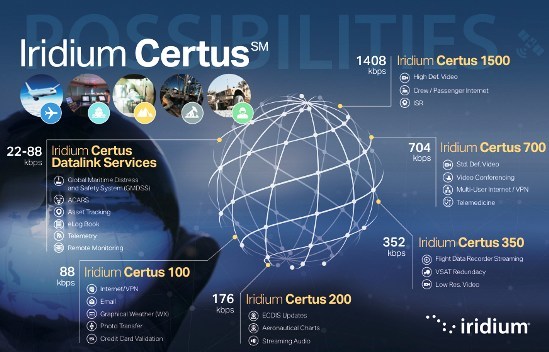WASHINGTON — With its full second-generation constellation now in orbit, Iridium has transferred all its communications services off of its two-decade-old legacy fleet.
A major benefit of the Iridium LEO Low-Earth-Orbiting satellites is latency (or ping time) is far far less than Geo-Stationary satellites since Iridium satellites are under 500 miles above earth and not 23,000 miles away. Iridium's network latency is expected to be 40 to 50 milliseconds! (In 2020 pinging at about 395ms +- 100 milliseconds). The Iridium Next system will be very useful airport communication and air traffic control. Satellites in the new constellation will have life span of about 20 years instead of 7 to 9 years lifespan of old satellites in original constellation. Iridium Satellite System features with constellation.
“For the first time since the initial launch of the system over 20 years ago, zero traffic is going through the old satellites,” Matt Desch, CEO of Iridium, said Feb. 6 at the National Press Club here.
Iridium Next Cost
The final two satellites in Iridium’s new fleet, called Iridium Next, entered service Feb. 5 at 2:15 p.m. Eastern, completing a refresh that began as the legacy fleet started to lose operational capability.
Desch said Iridium had already run out of spares and had lost one operational satellite by the time SpaceX launched the first Iridium Next satellites in January 2017.
“We were really operating a satellite short,” Desch said.
While Iridium was relying on 65 satellites instead of a nominal 66, the company had small service interruptions limited to “a few minutes outage once or twice a day” in areas where the satellite was absent, Desch said. The interruption was so minimal that customers were unaware, he said.
Iridium now has 75 satellites in orbit — 66 operational plus nine spares — and six spares on the ground. Desch said Iridium projects a lifespan of 15 years or more for the Iridium Next satellites.
European manufacturer Thales Alenia Space built Iridium Next, while Orbital ATK (now Northrop Grumman Innovation Systems) assembled and integrated the satellites in Gilbert, Arizona. SpaceX launched the entire constellation on eight Falcon 9 launches over the course of two years, with the final mission occurring Jan. 11.
Whereas the legacy fleet from Motorola and Lockheed Martin was designed mainly for voice communications, Iridium Next is optimized to support substantially more data services. Iridium announced Jan. 6 a transceiver with 35 times the data speed of existing devices. Desch said the device will be available mid-year to select ground segment manufacturers, and generally available by the end of the year.
Desch said Iridium has “deboosted” 52 legacy satellites, a process that involves lowering their orbits to catch the Earth’s atmosphere and burn up. So far, 47 legacy satellites have reentered, Desch said.
Iridium will deorbit the last 13 legacy satellites over the next few months. Desch said the average time between deboosting and complete deorbiting is 19 days.
 Please enable JavaScript to view the comments powered by Disqus.
Please enable JavaScript to view the comments powered by Disqus.The backbone of Aireon’s technology resides on the Iridium constellation of satellites. Eight Iridium NEXT launches on Space-X Falcon 9 rockets successfully occurred between January 2017 and January 2019. Iridium’s next generation satellite constellation will deliver exciting new innovations and opportunities, while ensuring continued high performance and reliability far into the future. To enable the Aireon system, Iridium will host specially designed receivers on each Iridium satellite, covering 100 percent of the globe.

Iridium low-latency, 66 cross-linked Low-Earth Orbit (LEO) satellites make it uniquely suited to meet the technical demands of global air traffic surveillance and tracking. The LEO satellites will orbit approximately 485 miles above the earth and each satellite will be linked to four others, creating a dynamic network to ensure continuous availability, everywhere on the planet.
Iridium Next
A Uniquely Sophisticated Architecture
Each Iridium satellite will be linked to four others – two in the same orbital plane and one in each adjacent plane – creating a dynamic mesh network that routes traffic among satellites to ensure a continuous connection, everywhere. This unique configuration allows services using the Iridium network to continue to remain unaffected by natural disasters, including hurricanes, tsunamis and earthquakes that can cripple terrestrial infrastructure.
Iridium Next Launch Schedule
Iridium Constellation Partners
Each of the 66 satellites in the Iridium constellation were built at the Orbital facility in Gilbert, Arizona, in addition to in-orbit and ground spares. The satellites were shipped to the Thales Alenia Space facility in Cannes, France where it underwent qualification testing to ensure robustness of design.
Iridium Next Modem
Iridium and Aireon
Iridium is hosting the Aireon system. It is the only satellite constellation with the capability and reach to enable global air traffic surveillance. This is all due to its orbital configuration. The configuration provides complete global coverage, including oceanic and polar regions, without the need for ground stations. The LEO altitude allows the aircraft signals to be received in space without any additional equipment or changes to the existing aircraft avionics. The intersatellite communications links will enable real-time delivery information to Air Traffic Control (ATC) to support aircraft separation services. No other system, existing or planned, will enable such an opportunity for aviation stakeholders.

